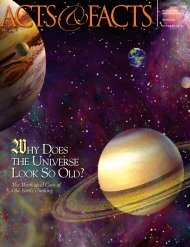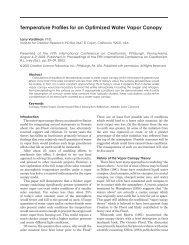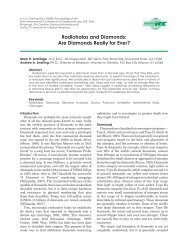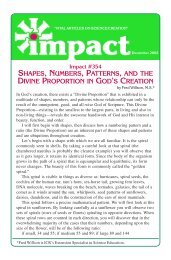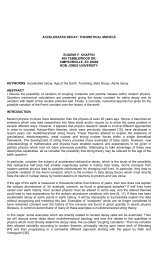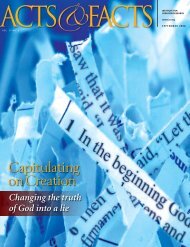Scientific Case Against Evolution booklet - Institute for Creation ...
Scientific Case Against Evolution booklet - Institute for Creation ...
Scientific Case Against Evolution booklet - Institute for Creation ...
You also want an ePaper? Increase the reach of your titles
YUMPU automatically turns print PDFs into web optimized ePapers that Google loves.
The <strong>Scientific</strong> <strong>Case</strong><strong>Against</strong> <strong>Evolution</strong>The Verdictis In!Henry M. Morris, Ph.D.
The <strong>Scientific</strong> <strong>Case</strong> <strong>Against</strong> <strong>Evolution</strong>byHenry M. Morris<strong>Institute</strong> <strong>for</strong> <strong>Creation</strong> Research
of dogs and many varieties ofcats, but no “dats” or “cogs.”Such variation is often calledmicroevolution, and these minorhorizontal (or downward)changes occur fairly often, butsuch changes are not true “vertical”evolution.<strong>Evolution</strong>ary geneticists have often experimentedon fruit flies and other rapidly reproducing speciesto induce mutational changes hoping they would leadto new and better species, but these have all failed toaccomplish their goal. No truly new species has everbeen produced, let alone a new “basic kind.”A current leading evolutionist, Jeffrey Schwartz,professor of anthropology at the University of Pittsburgh,has recently acknowledged that:. . . it was and still is the case that, with the exceptionof Dobzhansky’s claim about a new speciesof fruit fly, the <strong>for</strong>mation of a new species, by anymechanism, has never been observed. 1The scientific method traditionally has required experimentalobservation and replication. The fact thatmacroevolution (as distinct from microevolution) hasnever been observed would seem to exclude it from thedomain of true science. Even Ernst Mayr, the dean ofliving evolutionists, longtime professor of biology atHarvard, who has alleged that evolution is a “simplefact,” nevertheless agrees that it is an “historical5
science” <strong>for</strong> which “laws and experiments are inappropriatetechniques” 2 by which to explain it. Onecan never actually see evolution in action.<strong>Evolution</strong> Never Happened in the Past<strong>Evolution</strong>ists commonly answer the above criticismby claiming that evolution goes too slowly <strong>for</strong> us tosee it happening today. They used to claim that thereal evidence <strong>for</strong> evolution was in the fossil record ofthe past, but the fact is that the billions of knownfossils do not include a single unequivocal transitional<strong>for</strong>m with transitional structures in the process ofevolving.Given that evolution, according to Darwin, wasin a continual state of motion . . . it followed logicallythat the fossil record should be rife with examplesof transitional <strong>for</strong>ms leading from the lessto the more evolved. 3Even those who believe in rapid evolution recognizethat a considerable number of generations wouldbe required <strong>for</strong> one distinct “kind” to evolve into anothermore complex kind. There ought, there<strong>for</strong>e, tobe a considerable number of true transitional structurespreserved in the fossils—after all, there are billionsof non-transitional structures there! But (withthe exception of a few very doubtful creatures suchas the controversial feathered dinosaurs and the allegedwalking whales), they are not there.6
Instead of filling in the gapsin the fossil record with socalledmissing links, mostpaleontologists found themselvesfacing a situation in whichthere were only gaps in the fossilrecord, with no evidence of trans<strong>for</strong>mationalintermediates between documentedfossil species. 4The entire history of evolution from the evolutionof life from non-life to the evolution of vertebratesfrom invertebrates to the evolution of man from theape is strikingly devoid of intermediates: the links areall missing in the fossil record, just as they are in thepresent world.With respect to the origin of life, a leading researcherin this field, Leslie Orgel, after noting thatneither proteins nor nucleic acids could have arisenwithout the other, concludes:And so, at first glance, one might have to concludethat life could never, in fact, have originatedby chemical means. 5Being committed to total evolution as he is, Dr. Orgelcannot accept any such conclusion as that. There<strong>for</strong>e,he speculates that RNA may have come first, but thenhe still has to admit that:The precise events giving rise to the RNA worldremain unclear. . . . investigators have proposed7
many hypotheses, but evidence in favor of eachof them is fragmentary at best. 6Translation: “There is no known way by which lifecould have arisen naturalistically.” Un<strong>for</strong>tunately, twogenerations of students have been taught that StanleyMiller’s famous experiment on a gaseous mixture, practicallyproved the naturalistic origin of life. But not so!Miller put the whole thing in a ball, gave it an electriccharge, and waited. He found that amino acidsand other fundamental complex molecules wereaccumulating at the bottom of the apparatus. Hisdiscovery gave a huge boost to the scientific investigationof the origin of life. Indeed, <strong>for</strong> some timeit seemed like creation of life in a test tube waswithin reach of experimental science.Un<strong>for</strong>tunately, such experiments havenot progressed much furtherthan the original prototype, leavingus with a sour aftertaste fromthe primordial soup. 7Neither is there any clue as to how theone-celled organisms of the primordialworld could have evolved into the vast array of complexmulti-celled invertebrates of the Cambrian period.Even dogmatic evolutionist Gould admits that:The Cambrian explosion was the most remarkableand puzzling event in the history of life. 8Equally puzzling, however, is how some invertebratecreature in the ancient ocean, with all its “hardparts” on the outside, managed to evolve into the first8
vertebrate—that is, the first fish—with its hard partsall on the inside.Yet the transition from spineless invertebrates tothe first backboned fishes is still shrouded in mystery,and many theories abound. 9Other gaps are abundant, with no real transitionalseries anywhere. A very bitter opponent of creationscience, paleontologist, Niles Eldredge, has acknowledgedthat there is little, if any, evidence ofevolutionary transitions in the fossil record. Instead,things remain the same!It is a simple ineluctable truth that virtually allmembers of a biota remain basically stable, withminor fluctuations, throughout their durations.. . . 10So how do evolutionists arrive at their evolutionarytrees from fossils of oganisms which didn’t changeduring their durations?Fossil discoveries can muddle over attempts toconstruct simple evolutionary trees—fossils fromkey periods are often not intermediates, butrather hodge podges of defining features of manydifferent groups. . . . Generally, it seems that majorgroups are not assembled in a simple linearor progressive manner—new features are often“cut and pasted” on different groups at differenttimes. 11As far as ape/human intermediates are concerned,the same is true, although anthropologists have beeneagerly searching <strong>for</strong> them <strong>for</strong> many years. Many have9
een proposed, but each has beenrejected in turn.All that paleoanthropologistshave to show <strong>for</strong> more than 100years of digging are remains fromfewer than 2000 of our ancestors. Theyhave used this assortment of jawbones,teeth and fossilized scraps, together with molecularevidence from living species, to piece togethera line of human descent going back 5 to 8 millionyears to the time when humans and chimpanzeesdiverged from a common ancestor. 12Anthropologists supplemented their extremely fragmentaryfossil evidence with DNA and other types ofmolecular genetic evidence from living animals to tryto work out an evolutionary scenario that will fit. Butthis genetic evidence really doesn’t help much either,<strong>for</strong> it contradicts fossil evidence. Lewin notes that:The overall effect is that molecular phylogeneticsis by no means as straight<strong>for</strong>ward as its pioneersbelieved. . . . The Byzantine dynamics of genomechange has many other consequences <strong>for</strong> molecularphylogenetics, including the fact that differentgenes tell different stories. 13Summarizing the genetic data from humans, anotherauthor concludes, rather pessimistically:Even with DNA sequence data, we have no directaccess to the processes of evolution, so objective10
econstruction of the vanished past can beachieved only by creative imagination. 14Since there is no real scientific evidence that evolutionis occurring at present or ever occurred in thepast, it is reasonable to conclude that evolution is nota fact of science, as many claim. In fact, it is not evenscience at all, but an arbitrary system built upon faithin universal naturalism.Actually, these negative evidences against evolutionare, at the same time, strong positive evidences<strong>for</strong> special creation. They are, in fact, specific predictionsbased on the creation model of origins.<strong>Creation</strong>ists would obviously predict ubiquitousgaps between created kinds, though with many varietiescapable of arising within each kind, in order toenable each basic kind to cope with changing environmentswithout becoming extinct. <strong>Creation</strong>ists alsowould anticipate that any “vertical changes” in organizedcomplexity would be downward, since theCreator (by definition) would create things correctlyto begin with. Thus, arguments and evidences againstevolution are, at the same time, positive evidences<strong>for</strong> creation.The Equivocal Evidence from GeneticsNevertheless, because of the lack of any direct evidence<strong>for</strong> evolution, evolutionists are increasinglyturning to dubious circumstantial evidences, suchas similarities in DNA or other biochemical compo-11
nents of organisms as their “proof” that evolutionis a scientific fact. A number of evolutionists haveeven argued that DNA itself is evidence <strong>for</strong> evolutionsince it is common to all organisms. More oftenis the argument used that similar DNA structuresin two different organisms proves common evolutionaryancestry.Neither argument is valid. There is no reason whateverwhy the Creator could not or would not use thesame type of genetic code based on DNA <strong>for</strong> all Hiscreated life <strong>for</strong>ms. This is evidence <strong>for</strong> intelligent designand creation, not evolution.The most frequently cited example of DNA commonalityis the human/chimpanzee “similarity,” notingthat chimpanzees have more than 90% of theirDNA the same as humans. This is hardly surprising,however, considering the many physiological resemblancesbetween people and chimpanzees. Whyshouldn’t they have similar DNA structures in comparison,say, to the DNA differences between men andspiders?Similarities—whether of DNA, anatomy,embryonic development, or anything else—are better explained in terms of creationby a common Designer than by evolutionaryrelationship. The great differencesbetween organisms are of greater significancethan the similarities, and evolutionismhas no explanation <strong>for</strong> these if they12
all are assumed to have had the same ancestor. Howcould these great gaps between kinds ever arise atall, by any natural process?The apparently small differences between humanand chimpanzee DNA obviously produce very greatdifferences in their respective anatomies, intelligence,etc. The superficial similarities between all apes andhuman beings are nothing compared to the differencesin any practical or observable sense.Nevertheless, evolutionists, having largely becomedisenchanted with the fossil record as a witness <strong>for</strong>evolution because of the ubiquitous gaps where thereshould be transitions, recently have been promotingDNA and other genetic evidence as proof of evolution.However, as noted above by Roger Lewin, this isoften inconsistent with, not only the fossil record, butalso with the comparative morphology of the creatures.Lewin also mentions just a few typical contradictionsyielded by this type of evidence in relation tomore traditional Darwinian “proofs.”The elephant shrew, consigned by traditionalanalysis to the order insectivores . . . is in factmore closely related to . . . the true elephant. Cowsare more closely related to dolphins than they areto horses. The duck-billed platypus . . . is on equalevolutionary footing with . . . kangaroos and koalas.15There are many even more bizarre comparisonsyielded by this approach.13
The abundance of so-called “junk DNA” in the geneticcode also has been offered as a special type ofevidence <strong>for</strong> evolution, especially those genes whichthey think have experienced mutations, sometimescalled “pseudogenes.” 16 However, evidence is accumulatingrapidly today that these supposedly uselessgenes do actually per<strong>for</strong>m useful functions.Enough genes have already been uncovered in thegenetic midden to show that what was once thoughtto be waste is definitely being transmitted into scientificcode. 17It is thus wrong to decide that junk DNA, even theso-called “pseudogenes,” have no function. That ismerely an admission of ignorance and an object <strong>for</strong>fruitful research. Like the so-called “vestigial organs”in man, once considered as evidence of evolution butnow all known to have specific uses, so the junk DNAand pseudogenes most probably are specifically usefulto the organism, whether or not those uses haveyet been discovered by scientists.At the very best this type of evidence is strictly circumstantialand can be explained just as well in termsof primeval creation supplemented in some cases bylater deterioration, just as expected in the creationmodel.The real issue is, as noted be<strong>for</strong>e, whether there isany observable evidence that evolution is occurringnow or has ever occurred in the past. As we have seen,even evolutionists have to acknowledge that this type14
of real scientific evidence <strong>for</strong> evolution does not exist.A good question to ask is: Why are all observableevolutionary changes either horizontal and trivial (socalledmicroevolution) or downward toward deteriorationand extinction? The answer seems to be foundin the universally applicable laws of the science ofthermodynamics.<strong>Evolution</strong> Could Never Happen at AllThe main scientific reason why there is no evidence<strong>for</strong> evolution in either the present or the past (exceptin the creative imagination of evolutionary scientists)is because one of the most fundamental laws of natureprecludes it. The law of increasing entropy—alsoknown as the second law of thermodynamics—stipulatesthat all systems in the real world tend to go“downhill,” as it were, toward disorganization anddecreased complexity.This law of entropy is, by any measure, one of themost universal, best-proved laws of nature. It appliesnot only in physical and chemical systems, but alsoin biological and geological systems—in fact, in allsystems, without exception.No exception to the second law of thermodynamicshas ever been found—not even a tiny one. Likeconservation of energy (the “first law”), the existenceof a law so precise and so independent ofdetails of models must have a logical foundation15
that is independent of the fact that matter is composedof interacting particles. 18The author of this quote is referring primarily tophysics, but he does point out that the second law is“independent of details of models.” Besides, practicallyall evolutionary biologists are reductionists—that is, they insist that there are no “vitalist” <strong>for</strong>cesin living systems, and that all biological processes areexplicable in terms of physics and chemistry. Thatbeing the case, biological processes also must operatein accordance with the laws of thermodynamics,and practically all biologists acknowledge this.<strong>Evolution</strong>ists commonly insist, however, that evolutionis a fact anyhow, and that the conflict is resolvedby noting that the earth is an “open system,”with the incoming energy from the sun able to sustainevolution throughout the geological ages in spiteof the natural tendency of all systems to deterioratetoward disorganization. That is how an evolutionaryentomologist has dismissed W. A. Dembski’s impressiverecent book, Intelligent Design. This scientist defendswhat he thinks is “natural processes’ ability toincrease complexity” by noting what he calls a “flaw”in “the arguments against evolution based on the secondlaw of thermodynamics.” And what is this flaw?Although the overall amount of disorder in aclosed system cannot decrease, local order withina larger system can increase even without theactions of an intelligent agent. 1916
This naive response to the entropy law is typicalof evolutionary dissimulation. While it is true thatlocal order can increase in an open system if certainconditions are met, the fact is that evolution does notmeet those conditions. Simply saying that the earthis open to the energy from the sun says nothing abouthow that raw solar heat is converted into increasedcomplexity in any system, open or closed.The fact is that the best known and most fundamentalequation of thermodynamics says that the influxof heat into an open system will increase the entropyof that system, not decrease it. All known casesof decreased entropy (or increased organization) inopen systems involve a guiding program of some sortand one or more energy conversion mechanisms.<strong>Evolution</strong> has neither of these. Mutations are not“organizing” mechanisms, but disorganizing (in accordwith the second law). They are commonly harmful,sometimes neutral, but never beneficial (at leastas far as observed mutations are concerned). Naturalselection cannot generate order, but can only“sieve out” the disorganizing mutations presentedto it, thereby conserving the existing order, but nevergenerating new order. In principle, it may be barelyconceivable that evolution could occur in open systems,in spite of the tendency of all systems to disintegratesooner or later. But no one yet has been ableto show that it actually has the ability to overcomethis universal tendency, and that is the basic reason17
why there is still no bona fide proof of evolution, pastor present.From the statements of evolutionists themselves,there<strong>for</strong>e, we have learned that there is no real scientificevidence <strong>for</strong> real evolution. The only observableevidence is that of very limited horizontal (or downward)changes within strict limits.<strong>Evolution</strong> is Religion—Not ScienceIn no way does the idea of particles-to-people evolutionmeet the long-accepted criteria of a scientifictheory. There are no such evolutionary transitionsthat have ever been observed in the fossil record ofthe past; and the universal law of entropy seems tomake it impossible on any significant scale.<strong>Evolution</strong>ists claim that evolution is a scientificfact, but they almost always lose scientific debateswith creationist scientists. Accordingly, mostevolutionists now decline opportunities <strong>for</strong>scientific debates, preferring instead to makeunilateral attacks on creationists.Scientists should refuse <strong>for</strong>mal debatesbecause they do more harm than good,but scientists still need to counter thecreationist message. 20The question is, just why do they need to counterthe creationist message? Why are they so adamantlycommitted to anti-creationism?18
The fact is that evolutionists believe in evolutionbecause they want to. It is their desire at all costs toexplain the origin of everything without a Creator.<strong>Evolution</strong>ism is thus intrinsically an atheistic religion.Some may prefer to call it humanism, and “newage” evolutionists place it in the context of some <strong>for</strong>mof pantheism, but they all amount to the same thing.Whether atheism or humanism (or even pantheism),the purpose is to eliminate a personal God from anyactive role in the origin of the universe and all itscomponents, including man.The core of the humanistic philosophy is naturalism—theproposition that the natural world proceedsaccording to its own internal dynamics, withoutdivine or supernatural control or guidance, andthat we human beings are creations of that process.It is instructive to recall that the philosophersof the early humanistic movement debated as towhich term more adequately described their position:humanism or naturalism. The two conceptsare complementary and inseparable. 21Since both naturalism and humanism exclude Godfrom science or any other active function in the creationor maintenance of life and the universe in general,it is very obvious that their position is nothingbut atheism. And atheism, no less than theism, is areligion! Even doctrinaire-atheistic evolutionist RichardDawkins admits that atheism cannot be provedto be true.19
Of course we can’t prove that there isn’t a God. 22There<strong>for</strong>e, they must believe it, and that makes it areligion.The atheistic nature of evolution is not only admitted,but insisted upon by most of the leaders ofevolutionary thought. Ernst Mayr, <strong>for</strong> example, saysthat:Darwinism rejects all supernatural phenomenaand causations. 23A professor in the Department of Biology at KansasState University says:Even if all the data point to an intelligent designer,such a hypothesis is excluded from science becauseit is not naturalistic. 24It is well known by almost everyone in the scientificworld today that such influential evolutionistsas Stephen Jay Gould and Edward Wilson of Harvard,Richard Dawkins of England, William Provine ofCornell, and numerous other evolutionary spokesmenare dogmatic atheists. Eminent scientific philosopherand ardent Darwinian atheist Michael Ruse has evenacknowledged that evolution is their religion!<strong>Evolution</strong> is promoted by its practitioners as morethan mere science. <strong>Evolution</strong> is promulgated asan ideology, a secular religion—a full-fledged alternativeto Christianity, with meaning and morality. . . . <strong>Evolution</strong> is a religion. This was trueof evolution in the beginning, and it is true ofevolution still today. 2520
Another way of saying “religion” is “worldview,”the whole of reality. The evolutionary worldview appliesnot only to the evolution of life, but even to thatof the entire universe. In the realm of cosmic evolution,our naturalistic scientists depart even furtherfrom experimental science than life scientists do,manufacturing a variety of evolutionary cosmologiesfrom esoteric mathematics and metaphysical speculation.Socialist Jeremy Rifkin has commented on thisremarkable game.Cosmologies are made up of small snippets ofphysical reality that have been remodeled by societyinto vast cosmic deceptions. 26They must believe in evolution, there<strong>for</strong>e, in spite ofall the evidence, not because of it. And speaking ofdeceptions, note the following remarkable statement.We take the side of science in spite of the patentabsurdity of some of its constructs, . . . in spite ofthe tolerance of the scientific community <strong>for</strong> unsubstantiatedcommitment to materialism. . . . weare <strong>for</strong>ced by our a priori adherence to materialcauses to create an apparatus of investigation andset of concepts that produce material explanations,no matter how counterintuitive, no matterhow mystifying to the uninitiated. Moreover, thatmaterialism is absolute, <strong>for</strong> we cannot allow aDivine Foot in the door. 27The author of this frank statement is RichardLewontin of Harvard. Since evolution is not a labo-21
atory science, there is no way to test its validity, soall sorts of just-so stories are contrived to adorn thetextbooks. But that doesn’t make them true! Anevolutionist reviewing a recent book by another (butmore critical) evolutionist, says:We cannot identify ancestorsor “missinglinks,” and we cannotdevise testable theoriesto explain howparticular episodes ofevolution came about.Gee is adamant thatall the popular stories about how the first amphibiansconquered the dry land, how the birdsdeveloped wings and feathers <strong>for</strong> flying, how thedinosaurs went extinct, and how humans evolvedfrom apes are just products of our imagination,driven by prejudices and preconceptions. 28A fascinatingly honest admission by a physicist indicatesthe passionate commitment of establishmentscientists to naturalism. Speaking of the trust studentsnaturally place in their highly educated collegeprofessors, he says:And I use that trust to effectively brainwash them.. . . our teaching methods are primarily those ofpropaganda. We appeal—without demonstration—toevidence that supports our position. Weonly introduce arguments and evidence that22
supports the currently accepted theories and omitor gloss over any evidence to the contrary. 29<strong>Creation</strong>ist students in scientific courses taught byevolutionist professors can testify to the frustratingreality of that statement. <strong>Evolution</strong> is, indeed, thepseudo-scientific basis of religious atheism, as Rusepointed out. Will Provine at Cornell University is anotherscientist who frankly acknowledges this.As the creationists claim, belief in modern evolutionmakes atheists of people. One can have a religiousview that is compatible with evolution onlyif the religious view is indistinguishable fromatheism. 30Once again, we emphasize that evolution is not science,evolutionists’ tirades notwithstanding. It is aphilosophical worldview, nothing more.(<strong>Evolution</strong>) must, they feel, explain everything. . . .A theory that explains everything might just aswell be discarded since it has no real explanatoryvalue. Of course, the other thing about evolutionis that anything can be said because very littlecan be disproved. Experimental evidence is minimal.31Even that statement is too generous. Actual experimentalevidence demonstrating true evolution (thatis, macroevolution) is not “minimal.” It is nonexistent!The concept of evolution as a <strong>for</strong>m of religion isnot new. In my book, The Long War <strong>Against</strong> God, 32 I23
documented the fact that some <strong>for</strong>m of evolution hasbeen the pseudo-rationale behind every anti-creationistreligion since the very beginning of history. Thisincludes all the ancient ethnic religions, as well assuch modern world religions as Buddhism, Hinduism,and others, as well as the “liberal” movements in eventhe creationist religions (Christianity, Judaism, Islam).As far as the twentieth century is concerned, theleading evolutionist is generally considered to be SirJulian Huxley, primary architect of modern neo-Darwinism.Huxley called evolution a “religion withoutrevelation” and wrote a book with that title (2nd edition,1957). In a later book, he said:<strong>Evolution</strong> . . . is the most powerful and the mostcomprehensive idea that has ever arisen onearth. 33Later in the book he argued passionately that we mustchange “our pattern of religious thought from a Godcenteredto an evolution-centered pattern.” 34 Then hewent on to say that: “The God hypothesis . . . is becomingan intellectual and moral burden on our thought.”There<strong>for</strong>e, he concluded that “we must construct somethingto take its place.” 35That something, of course, is the religion of evolutionaryhumanism, and that is what the leaders ofevolutionary humanism are trying to do today.In closing this survey of the scientific case againstevolution (and, there<strong>for</strong>e, <strong>for</strong> creation), the reader is24
eminded again that all quotations in the article arefrom doctrinaire evolutionists. No Bible referencesare included, and no statements by creationists. Theevolutionists themselves, to all intents and purposes,have shown that evolutionism is not science, but religiousfaith in atheism.25
References1. Jeffrey H. Schwartz, Sudden Origins (New York, John Wiley,1999), p. 300.2. Ernst Mayr, “Darwin’s Influence on Modern Thought,”<strong>Scientific</strong> American (vol. 283, July 2000), p. 83.3. Jeffrey H. Schwartz, op. cit., p.89.4. Ibid.5. Leslie E. Orgel, “The Origin of Life on the Earth,” <strong>Scientific</strong>American (vol. 271, October 1994), p. 78.6. Ibid., p. 83.7. Massimo Pigliucci, “Where Do We Come From?” SkepticalInquirer (vol. 23, September/October 1999), p. 24.8. Stephen Jay Gould, “The <strong>Evolution</strong> of Life,” chapter 1 in<strong>Evolution</strong>: Facts and Fallacies, ed. by J. William Schopf (SanDiego, CA., Academic Press, 1999), p. 9.9. J. O. Long, The Rise of Fishes (Baltimore: John HopkinsUniversity Press, 1995), p. 30.10. Niles Eldredge, The Pattern of <strong>Evolution</strong> (New York: W. H.Freeman and Co., 1998), p. 157.11. Neil Shubin, “<strong>Evolution</strong>ary Cut and Paste,” Nature (vol. 349,July 2, 1998), p.12.12. Colin Tudge, “Human Origins Revisited,” New Scientist (vol.146, May 20, 1995), p. 24.13. Roger Lewin, “Family Feud,” New Scientist (vol. 157, January24, 1998), p. 39.14. N. A. Takahata, “Genetic Perspective on the Origin and Historyof Humans,” Annual Review of Ecology and Systematics (vol.26, 1995), p. 343.15. Lewin, op. cit., p. 36.16. Rachel Nowak, “Mining Treasures from ‘Junk DNA’,” Science(vol. 263, February 4, 1994), p. 608.26
17. Ibid.18. E. H. Lieb and Jakob Yngvason, “A Fresh Look at Entropy andthe Second Law of Thermodynamics,” Physics Today (vol. 53,April 2000), p. 32.19. Norman A. Johnson, “Design Flaw,” American Scientist (vol.88. May/June 2000), p. 274.20. Scott, Eugenie, “Fighting Talk,” New Scientist (vol. 166, April22, 2000), p.47. Dr. Scott is director of the anti-creationistorganization euphemistically named, The National Center <strong>for</strong>Science Education.21. Ericson, Edward L., “Reclaiming the Higher Ground,” TheHumanist (vol. 60, September/October 2000), p. 30.22. Dawkins, Richard, replying to a critique of his faith in theliberal journal, Science and Christian Belief (vol. 7, 1994), p.47.23. Mayr, Ernst, “Darwin’s Influence on Modern Thought,”<strong>Scientific</strong> American (vol. 283, July 2000), p. 83.24. Todd, Scott C., “A View from Kansas on the <strong>Evolution</strong>Debates,” Nature (vol. 401, September 30, 1999), p. 423.25. Ruse, Michael, “Saving Darwinism fron the Darwinians,”National Post (May 13, 2000), p. B-3.26. Rifkin, Jeremy, “Reinventing Nature,” The Humanist (vol. 58,March/April 1998), p. 24.27. Lewontin, Richard, Review of the Demon-Haunted World, byCarl Sagan. In New York Review of Books, January 9, 1997.28. Bowler, Peter J., Review In Search of Deep Time by Henry Gee(Free Press, 1999), American Scientist (vol. 88, March/April2000), p. 169.29. Singham, Mark, “Teaching and Propaganda,” Physics Today(vol. 53, June 2000), p. 54.30. Provine, Will, “No Free Will,” in Catching Up with the Vision,ed. by Margaret W. Rossiter (Chicago: University of ChicagoPress, 1999), p. S123.31. Appleyard, Bryan, “You Asked <strong>for</strong> It,” New Scientist (vol. 166,April 22, 2000), p. 45.27
32. Henry M. Morris, The Long War <strong>Against</strong> God (Grand Rapids,Michigan: Baker Book House, 1989), 344 pp.33. Julian Huxley, Essays of a Humanist (New York: Harper andRow, 1964), p. 125.34. Ibid., p. 222.35. Ibid.28
INSTITUTE <strong>for</strong> CREATION RESEARCH10946 Woodside Avenue NorthSantee, CA 92071619/448-0900Customer Service: 800/628-7640www.icr.org







